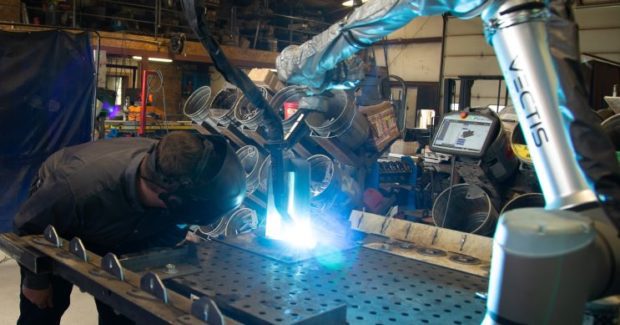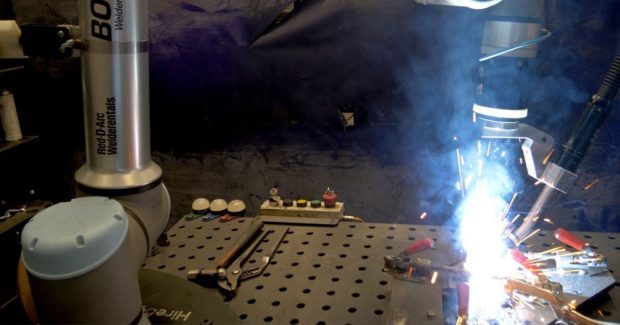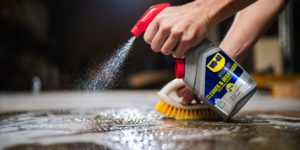Automation in the Fab Shop?
Discover how collaborative robots are solving long standing production challenges.
Posted: January 3, 2022
ADVANCING AUTOMATION
By Joe Campbell
Fabrication shops have historically been extremely difficult, if not impossible, to automate. For example, in contract packaging, injection molding and assembly operations, the HM/LV (High Mix/Low Volume) nature of the business turns any investment in traditional automation upside down. Listed below are the most common barriers:
- 1:1 Robot to Machine Ratio – Traditional automation is a hard, inflexible installation. The robot is bolted to the floor, surrounded by safety guarding and dedicated parts infeed/outfeed equipment. And if the application is machine tending, the robot is typically directly in front of the door in the space a manual operator would occupy. For this investment to generate ROI, the shop owner/manager must be confident in a steady volume of production that fit both the machine and the robot.
- Relationship of Batch Sizes to Set Up Time – “I’ll just weld it myself…I can finish the job in the same time it would take me to program the robot.” For small batch sizes, this is a common refrain. Some shops produce in bigger lots to reduce the overall set up time, in the hopes the customer will order additional units. But this has significant impact on inventory and cash flow.
- High + Unpredictable Mix/Low Volume – High mix is difficult enough, but when customer orders include a steady stream of new parts, the shop is constantly programming and reprogramming and changing set ups.
- Workforce Motivation – Keeping the manufacturing team motivated requires automating the 3 Ds: Dull, Dirty, Dangerous tasks. For highly skilled welders and operators, a steady stream of simple low complexity parts is dull, and distractions allow quality issues to creep in.
- Cost/Payback versus Labor – Most fabrication shops run on modest margins, and when the cost of a traditional robot cell approaches $200,000, ROI stretches out to two+ years. Of course, this assumes the shop owner can find skilled labor to hire.
ENTER THE COBOT
Collaborative robots, or cobots, are changing the production model in fabrication shops around the world. Cobots directly address the barriers to automation that have limited traditional robots in HM/LV fabrication shops.
- Robot-as-a-Tool – Because of their ability to safely operate side-by-side with skilled operators (risk assessment required) and simplified programming and set up, cobots can easily be mounted on carts or mobile platforms. In many shops, fleets of cobots for welding, cutting and machine tending are moved from machine to machine based on the daily production schedule.
- Shrinking Batch Sizes – Cobots can easily be re-programmed and set up for new parts. “I can program it faster than I can weld it” is the new mantra in the shop.
- Incremental Investment – Cobot solutions for common fabrication shop operations such as welding and machine tending are available for $70,000-to-$90,00, in most cases less than the annual, fully burdened, cost of a skilled welder or operator.
- Motivated Workforce – Due to their flexibility and simplified programming, it is straight-forward to deploy cobots on the simple parts that quickly bore skilled welders and operators. In most shops, the skilled workforce is moved to higher value-added tasks, or into new roles setting up and deploying the cobots.
How does this play out in practice? Outlined below are recent cobot deployments.
MT SOLAR OVERCOMES LABOR SHORTAGES, BOOSTS QUALITY AND IMPROVES PRODUCTIVITY
MT Solar is a solar mounting equipment manufacturer facing a 300 percent jump in demand for its solar mount products every summer. The company was unable to find skilled welders to handle the seasonal uptick with lead times two to three times what they were supposed to be.
Finding a versatile automation solution was crucial for MT Solar as the company makes several types of mounting parts, often in HM/LV batches. MT Solar owner and president, Travis Jordan, first looked into traditional industrial robots but realized the cost and deployment time was prohibitive. “Conventional robots aren’t very flexible,” Jordan said. “They can’t handle a mixed bag. The fixturing can’t be manipulated properly, and the cost would have gone through the roof.” He added that the company preferred a solution that wouldn’t require safety guarding and that existing operators could handle.
When MT Solar discovered cobots, the paradigm changed. “The big difference is the ‘collaborative robot approach’ of being able to work with the robot, and it being so teachable and so easy to run,” Jordan said. Operators set up the cell with jigs, supply the parts and program the cobot-powered weld system through an intuitive 3D interface directly integrated on the cobot’s teach pendant. The pendant includes a full weld library providing standard settings for common weld jobs, including pattern and tack tools.
“I am by no means a certified welder,” Jordan said. “I’ll just grab any of the guys out of the shop that are welders, and I’ll say, ‘Okay, I’ll run the pendant. You go ahead and run the torch and put it where you want it. ’And we’ve thought through some very advanced welds.”
Programming complete, the robot autonomously runs a full MIG welding cycle. The cobot welds six to eight parts in each cycle. Typically, these are small parts, including lock collars, beam clamps and weld nuts. When it has completed its welding tasks, humans can reload parts and restart the system, if required, or quickly program a new welding job with fresh parts. The cobot is responsible for welding specific lists of parts every 38-minute takt time shift. Operators work collaboratively with the cobot, loading and unloading during cycles and maximizing the build reach of the machine to cover multiple different fixtures.
COBOT ELIMINATES BOTTLENECKS, REDUCES WELDING TIME BY HALF AT SIOUXLAND FABRICATING
Siouxland Fabricating in Iowa successfully deployed a cobot on a HM/LV stamping application, in which the cobot picks a part, places it in a stamping machine, actuates the machine, and then palletizes the finished part. Based on these positive cobot experiences, it was a small step for Siouxland Fabricating to ask, “Can we stick a welding arm on the end of our UR robot and make it weld?”
The answer was yes. Soon after the new cobot-powered welder arrived, welders at Siouxland Fabricating were programming complicated welds using a combination of hand-guiding and the cobot system’s smartphone application. Siouxland Fabricating’s CTO Toby Boogerd, explains that the cobot can be operated by a welder alone. “The cobot enables us to let the welder move the robot and create the program on the fly,” Boogerd said. “This was something we had always hoped for, and we found the solution. I can weld on the UR robot too; even though I can’t hand weld.”
Matt Van DeKamp, weld robot supervisor and programmer at Siouxland Fabricating, appreciates the simplicity of the cobot programming process: “Probably the biggest thing with the cobot is being able to get it from Point A to Point B in a fraction of the time,” DeKamp said. “You also have corrective positioning that takes care of positioning and your angle — which is everything in welding. I no longer need the help of the hand welder, or his opinion of how he would hold his torch. That’s a big deal.”
BotX has also enabled Siouxland to perform more advanced welds. “Traditionally, we would just do two or three passes on welding because we didn’t understand how to use some of those more advanced features,” Boogerd said. “But having used the UR robot, we’re able to use the weaving feature, which cuts cycle time in half. It also saves on consumables since we’re not laying all that extra gas and bead.”
COBOTS: MULTITUDE OF USES
Cobot automation continues to expand the applications and weld processes they are automating. Today leading cobot brands are used in:
- MIG
- TIG
- Cold-Wire Feed TIG
- MIG Aluminum
- Plasma Cutting
- High Deposition
- Multi-Pass
- Touch Sensing
- Thru Arc Seam Tracking
- Pulse
- Cold Metal Transfer
- Submerged Arc
- Dual- or Twin-Arc
- Cladding
- Hardfacing
- Flame Spray
- Die Repair
- Brazing
- Additive Manufacturing
Power Supplies
- Miller
- Fronius
- Lincoln Electric
- Hypertherm (Plasma Cutting)
- ESAB
- OTC
- Lorch
- Thermal Dynamics


















